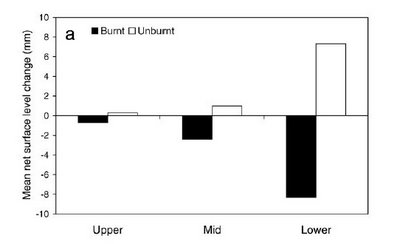9 February 2009
Australian wildfires and risks of increased erosion rates
Posted by Dave Petley
![]() (Updated 10th Feb to include latest casualty numbers)
(Updated 10th Feb to include latest casualty numbers)
The extraordinary wildfires in Australia are dominating the headlines in the UK, half a world away. Wildfires are quite common events, but the number of fatalities that this particular episode has caused is really quite unusual. Below in Figure 1 I have plotted the recorded worldwide recorded number of deaths from wildfires for the period since 1980, using data from the CRED EM-DAT database . I have added the (updated to) 173 reported deaths from this event so far as an extra column, although note that reports suggest that this total may rise substantially:
 Figure 1: Global numbers of reported fatalities from widlfires, based upon the CRED EM-DAT database. The 2009 value is the reported number of deaths from the Austrlian wildfires.
Figure 1: Global numbers of reported fatalities from widlfires, based upon the CRED EM-DAT database. The 2009 value is the reported number of deaths from the Austrlian wildfires.The average annual global total number of deaths is 59.5 fatalities per annum. Care is needed in the interpretation of the above as CRED only record events that kill ten or more people, thus these values consistently underestimate the true toll, but nonetheless the unusual impact of these events is clear.
In the context of this blog it is also interesting to think through the likely long term impact of these fires in terms of erosion and landslides. A recent paper by Smith and Dragovitch (2008) looked at the long term consequences of wildfires in SE. Australia. These two researchers have published extensively on sediment production and erosion in Australia, so have a strong pedigree.
The study focused on a fire that occurred in January 2003 during a drought in the Snowy Mountains near to Thredbo (Fig. 2), a sub-alpine environment. The study used erosion pins to monitor surface level change on both burnt and unburnt hillslopes over a period of 795 days after the fire.
The study showed that after the fire the areas that had been burnt suffered a net loss of soil representing an average of 3.8 mm of material, with the most intense erosion occurring on the lower slopes (Fig. 3). On the other hand, the unburnt areas saw a net accumulation of soil of an average of 2.6 mm, again with the greatest accumulation at the lower slopes.
 Figure 3: Mean net soil loss and gain for burnt and unburnt areas as reported by Smith and Dragovich (2008).
Figure 3: Mean net soil loss and gain for burnt and unburnt areas as reported by Smith and Dragovich (2008).Thus, the burnt areas clearly suffered a net loss of material in the aftermath of the fires. The study showed that this loss of soil declined with time after the fire, with a slight increase again during snow melt, presumably as vegetation re-established. However, these values are perhaps surprisingly low compared with those recorded in other environments, especially in N. America, given the steep slope angles seen in Figure 2. Interestingly, Shakesby et al. (2007), who studied post-fire erosion in Eucalyptus forests in SE. Australia, came to similar conclusions, stating that “except under extreme post-fire rainfall conditions, present-day wildfires affecting south-east Australia seem to be less potent in geomorphological terms than might be expected given the severity and frequency of the wildfires“. They attribute this to the rapid rate of plant growth in the aftermath of fires plus the resistance of the soil to erosion.
The conclusion is therefore that although the fires have devastated vast areas, and made thousands homeless, there should not be a serious increase in erosion in the burnt areas. This will help greatly in the post-fire recovery of the burnt areas.
References:
H SMITH, D DRAGOVICH (2008). Post-fire hillslope erosion response in a sub-alpine environment, south-eastern Australia CATENA, 73 (3), 274-285 DOI: 10.1016/j.catena.2007.11.003
R SHAKESBY, P WALLBRINK, S DOERR, P ENGLISH, C CHAFER, G HUMPHREYS, W BLAKE, K TOMKINS (2007). Distinctiveness of wildfire effects on soil erosion in south-east Australian eucalypt forests assessed in a global context Forest Ecology and Management, 238 (1-3), 347-364 DOI: 10.1016/j.foreco.2006.10.029



 Dave Petley is the Vice-Chancellor of the University of Hull in the United Kingdom. His blog provides commentary and analysis of landslide events occurring worldwide, including the landslides themselves, latest research, and conferences and meetings.
Dave Petley is the Vice-Chancellor of the University of Hull in the United Kingdom. His blog provides commentary and analysis of landslide events occurring worldwide, including the landslides themselves, latest research, and conferences and meetings.
The link below is to a workshop we had here in British Columbia in 2005, mostly spurred on by some devastating interface fires we had in 2003, which resulted (among other things) in some pretty spectacular landslides. There are some nice local examples, as well as links to more materials.http://www.forrex.org/program/water/wildfire.asp
We are Praying; Peace, Light, Hope, Love & Courage – God BlessAustralia Wildfires;There are no words to express the anguish;Words completely fail to come forth and our heart grieves for the loss of the victims of this terrible tragedy;We are deeply saddened and share your pain and it is with sadness in my heart that I write these few words; expressing our deepest sympathies and condolences;Our prayers and thoughts reach out those who have lost their loved ones;May God’s Blessings give you the strength and courage to overcome this enormous challengeAll of us are praying; Our thoughts are with youPeace, Light, Hope, Love & CourageGod Bless,Vashi
[…] Australian wildfires and risks of increased erosion rates […]